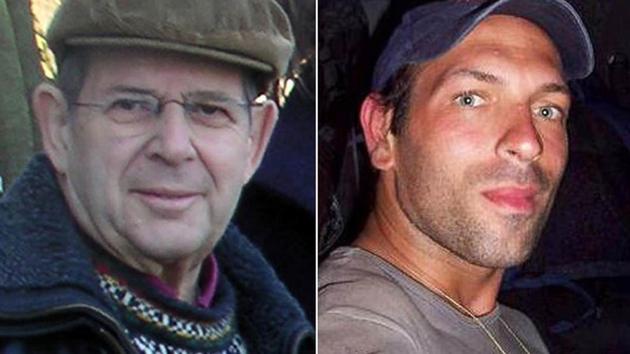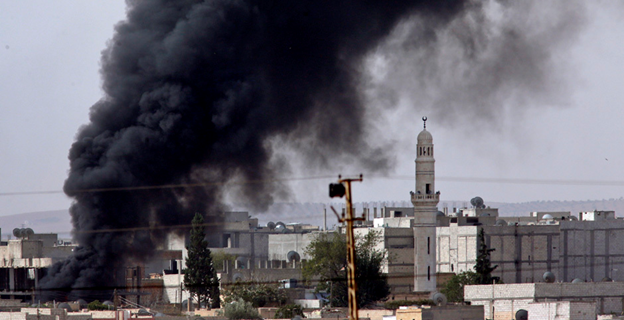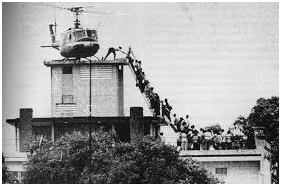Obama Apologizes for Drone Strike in Pakistan that Killed U.S. and Italian Hostages
The Wall Street Journal reported the disclosure of a classified drone attack on an Al Qaeda compound in January that mistakenly killed an American hostage, Dr. Warren Weinstein and Italian aid worker, Giovanni Lo Porto. An Al Qaeda senior operative, Ahmed Farouq who held dual U.S. and Pakistan citizenship was the target of the attack in the controversial CIA covert operation. Dr. Weinstein had been held since 2011. The WSJ noted the reactions of the President, Italian Premier Renzi and Weinstein’s widow:
The intelligence that underpinned the drone strike turned out to have been tragically incomplete, U.S. officials and lawmakers said Thursday.
The deaths prompted President Barack Obama, who has expanded and redefined the use of U.S. drones, to take full responsibility.
“I profoundly regret what happened. On behalf of the United States government I offer our deepest apologies to their families,” he said at the White House.
But Mr. Weinstein’s family expressed disillusionment at the U.S. and Pakistani approach to his capture and imprisonment by al Qaeda.
“We were so hopeful that those in the U.S. and Pakistani governments with the power to take action and secure his release would have done everything possible to do so, and there are no words to do justice to the disappointment and heartbreak we are going through,” said Elaine Weinstein, the American hostage’s widow.
Mr. Obama said he spoke with Italian Prime Minister Matteo Renzi and Mr. Weinstein’s family.
Mr. Obama knew about the deaths of the hostages when he met with Mr. Renzi in Washington last Friday but Mr. Obama didn’t tell him, a senior administration official said. Mr. Obama wanted to first develop a plan for sharing the news with the families and the public, the official said.
Mr. Renzi on Thursday expressed “deepest condolences” to the Lo Porto family, as well to the family of Mr. Weinstein. The Italian foreign ministry’s crisis unit immediately contacted Mr. Lo Porto’s family after Mr. Obama’s call.
However, the CIA drone strike that mistakenly killed the two hostages met the rules of engagement:
It was the first known instance in which the Central Intelligence Agency killed hostages in a drone strike. The deaths were a major blow to the spy agency, which conducts the attacks largely behind a cloak of secrecy.
The CIA used rules of engagement that allow drone strikes against suspected militants even if the agency isn’t sure who they are.
The White House has launched a review of the strike to see if changes are needed to the program to avoid similar mistakes in the future. Officials said the program hasn’t been curtailed so far in response.
But Mr. Obama said the initial U.S. assessment of the strike shows it was fully consistent with the guidelines under which his administration conducts such counterterrorism operations.
The CIA launched the strike that killed the hostages under the broad authorities given to the agency to target suspected al Qaeda targets in Pakistan, senior Obama administration officials said. Mr. Obama didn’t directly sign off on the strike beforehand, they said.
JM Berger, author of Jihad Joe: Americans Who Go to War in the name of Islam writes about the demise of three American Al Qaeda operatives: Adam Gadahn, Jewish convert to Salafist Islam who headed AQ Central Media operation, Samir Kahn who fled North Carolina to join American born AQAP leader, Anwar al Awlaki in Yemen to edit Inspire Magazine and Omar Hammami, a Daphne, Alabama native, born of a Baptist mother and Syrian Muslim engineer father, who became an Al Shabaab media star and commander.
The title of Berger’s Politico Magazine article, “Al Qaeda’s American Dream Ends” is both a chronicle of the trio’s exploits and circumstances about their demise. As we learned today, Gadahn was killed in a separate drone attack by the CIA covert program. Kahn was also killed in a drone strike in Yemen, as was American-born AQAP leader, Sheik Anwar al-Awlaki. The two hostages, American development expert Dr. Warren Weinstein and Italian aid worker Giovanni Lo Porto were killed in a US Drone strike under murky circumstances in January 2015 along with AQ leader Ahmed Farouq who had dual US and Pakistani citizenship. Farouq was allegedly head of Al Qaeda in the Indian Subcontinent (AQIS)
President Obama apologized and took responsibility as Commander in Chief for the failure of the mission to secure the freedom of the hostages, although the decision was delegated to others in the clandestine drone program. The error is reflective of the lack of intelligence assets, a product of reliance on drones to attack AQ leaders under approved rules of engagement.
Hammami was killed in an ambush by Al Shabaab in 2013 because he became increasingly critical of the leadership. Both Gadahn and Khan, as Berger points out, provided a template for the slick graphic/ video production and social media campaigns run by ISIS. The title of Berger’s piece is somewhat misleading. While Gadahn, Kahn and Hammami were prominent American Jihadis, others, especially in the Muslim émigré communities in the US are taking their place as recruits for ISIS. For AQ the American Dream may have ended. For ISIS it is only just beginning with few prospects for counterterrorism echelons in our government to create effective de-radicalization programs aimed at preventing these Americans from joining the thongs of tens of thousands from around the Muslim ummah to fight and die for the pure Islamic State. That is because the President refuses to recognize the attraction of Salafist Jihadist Islam at the core of Muslim terrorism.
Today’s revelations illustrate why the U.S. has lost credibility in relying only on drone strikes to degrade AQ leadership rather than coordinating it with verifiable intelligence from assets in the field.
We understand completely the grief and frustration of the Weinstein and Lo Porto families who criticized both the US and Pakistani governments for not securing the freedom of their late loved ones languishing for years as AQ hostages.
EDITORS NOTE: This column originally appeared in the New English Review. The featured image is of Dr. Warren Weinstein U.S. Development expert and Giovanni Lo Porto Italian aid worker killed in January 2015 by a U.S. drone attack. Source: AP and Facebook Page.



